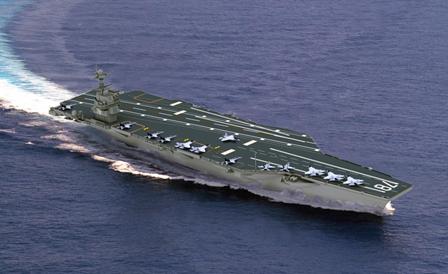Gerald R. Ford-class
Summary
| Origin country | 🇺🇸 United States |
| Category | Aircraft carrier |
| Subtype | Nuclear-powered fleet carrier |
| Manufacturer | Newport News Shipbuilding |
| Year commissioned | 2017 |
| Approx. unit cost | $12800 million |
| Units | CVN-78 USS Gerald R. Ford |
| Current operators | 🇺🇸 United States |
Description
The USS Gerald R. Ford (CVN-78) is the lead ship of her class, named in honor of the 38th U.S. President for his naval service during World War II. The carrier’s construction journey began with a ceremonial steel cut in August 2005, followed by the keel-laying ceremony in November 2009. The vessel was christened in November 2013 and subsequently entered the fleet to replace the decommissioned USS Enterprise (CVN-65). After a series of sea trials and overcoming developmental delays, the ship was formally commissioned into the United States Navy in July 2017.
As the largest warship ever constructed, the USS Gerald R. Ford introduces significant technological advancements over the preceding Nimitz-class. Displacing approximately 100,000 tons, its power is generated by two new-generation A1B nuclear reactors, allowing it to operate for decades without refueling and reach speeds in excess of 30 knots. Key innovations include the Electromagnetic Aircraft Launch System (EMALS) and Advanced Arresting Gear (AAG), which replace traditional steam systems. These technologies, combined with a redesigned flight deck and a smaller island positioned further aft, enable the ship to generate a higher rate of aircraft sorties with a smaller crew, projecting to save billions in operating costs over its lifespan. The ship can carry more than 75 aircraft and is equipped with advanced multi-band radar systems, surface-to-air missiles, and close-in weapon systems for self-defense.
Following its commissioning, the USS Gerald R. Ford underwent extensive operational testing, including full-ship shock trials to validate its durability in combat conditions. The carrier conducted its inaugural deployment in late 2022, participating in operations alongside NATO allies with port visits to Canada and the United Kingdom. Its first full-length deployment began in May 2023, operating in the areas of responsibility for the U.S. 2nd and 6th Fleets. During this deployment, the carrier engaged in NATO exercises and made port calls in Norway and Croatia. In October 2023, the Ford carrier strike group was directed to the Eastern Mediterranean to bolster regional deterrence efforts following the attack on Israel. The deployment was extended, with the carrier returning to its homeport of Norfolk in January 2024 after more than 230 days at sea.
Technical specifications
| Displacement | 100000 tons |
| Range | Unlimited, except by food supplies |
| Endurance | 50-year service life |
| Crew | 4539 members |
| Width | 78.0 m (255.9 ft) |
| Length | 337.0 m (1105.6 ft) |
| Air Park | 30 F/A-18E/F Super Hornets, 12 F/A-35 JSF fighters, 6 E/F-18G Growlers, 6 E-2D Hawkeyes, 6 MH-60R Seahawks |
| Propulsion | Two Bechtel A1B PWR nuclear reactors – 4 shafts |
| Thrust | 90000 hp |
| Armament | * Surface-to-air missiles: 2 × RIM-162 ESSM launchers |
| Maximum speed | 30 knots |
